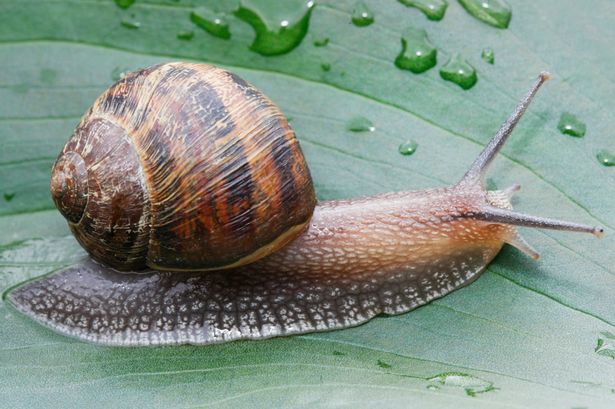I like to think I’m a believer in the permaculture ethic of fair share, but really, enough is enough. Since my autumn planting of kale, the humans in this ecosystem have managed to scrounge only two meals from 12 plants. The rest was gobbled by gastropods.

Cute is as cute does (photo: mirror.co.uk)
Northland snails are an agile and culinary venturesome bunch. Things you might never imagine as part of a snail diet have disappeared down their little gullets. The lavender and eau-de-cologne mint have both suffered, and the perpetual onions seem to be a current menu favorite. Someone once told me that when kale plants get tall enough the slimeys give up climbing. Not so the Northland crew, they just slither up that kale stem and keep right on munching.
Thus, I’ve declared war, and now, on any given night you can find me outside with a headlamp harvesting slugs and snails. Since I imagine I’m not the only one facing an invasion of invertebrates I thought I would let you in on my tips and tricks for how to run a successful snail patrol:
- For collection use a deep receptacle with a lid. I started off using an ice cream carton, but I’ve since adjusted my technique. It gets annoying to be constantly peeling your captives off the top of the container as they try to make their escape.
- Put a few sacrificial lettuce leaves in the bottom of your dungeon. This (see point one) helps to keep your slimy enemies entertained and in one place. I’m not sure why English uses the words snail’s pace, and sluggish to convey slow movement. When it comes to escaping from capture these guys can move.
- Collections seem to run in cycles. One night I find mainly snails, on another mainly slugs. It’s not clear what the controlling variables are for this phenomenon. Snails are fairly easy to pick up, but slugs are cold slimy things. Wear gloves if you’re squeamish.
- Remember to look at each plant from several different angles. According to this article snails have only two brain cells, but I swear they know how to dodge behind a leaf when they see me coming.
- Examine the ground just underneath your plants. Some slugs employ a drop and roll strategy.
- When it comes to the end game, humane methods of gastropod slaughter are generally suggested to be stomping or freezing. ‘Hello friends! Why yes, that is an ice cream carton of snails in our freezer’.
- If you are not game to kill them you need to know that research conducted on British snails showed that they have a homing instinct (no, really!). To avoid repopulation you need to move the enemy captives at least 20 metres away from your garden. I suspect that with the Northland snail’s innate athleticism I will need to allow for more like a 100 metre range.
My most recent means of ‘permanent disposal’ is expatriation to the chicken run. There I figure the crawlers have at least a sporting chance. There is the possibility of some of making it to the compost heap to live out their lives in their role as decomposers. For the less fortunate who become calories contributing to the laying of our breakfast eggs, at least their demise is a useful one. Seems like a reasonable deal to me.
Okay dear Readership, any tips for snail control? The comment box awaits.


meanie!
🙂
Ummm… I put out nasty chemicals all over the garden. But I know you are more pure than I 🙂
I am most pure, haha!
Ughh slug removal is the worst 🙁 my snails aren’t quite as upwardly mobile as yours but by then the caterpillars have taken over and something has the gall to eat my marigolds! Obviously an illiterate bunch we’ve got that haven’t read the gardening guides… No useful tips sorry (like companion planting marigolds ha) and all my offenders are ‘relocated’ onto the bricks for the birds to deal with.
Oh dear, shame about the marigolds, that was going to be my next intervention. The thrushes are fun to watch when eating snails, lots of shell shattering pounding on stones.
Encourage (somehow) hedgehogs to live at your place, or adopt a baby one and watch it eat, then smear itself with, the slimeyness. Although according to the Hedgehog Lady of Wgtn snails have some sort of parasite which isn’t good for h-hogs. Maybe just set up a tally sheet, keep on with the pickings, then stomp on them far enough away so as not to attract flies. (Or you could sprinkle salt on the captured ones and watch them fizz up.)
Love the hedgehog idea. Very permaculture. He or she could be called Mr / Mrs Tiggywinkle and sleep under the shelter belt. 🙂
Don’t forget the beer solution – then they drown but die happy?
Rachel says consider cornmeal as it is eaten by snails but kills them. However, R says to be careful it doesn’t encourage a bigger pest – Mr Ratty?. But wait there more:
1. Try foil barriers round plants to give them a shock .2 put down anything dusty or scratchy such as sawdust, sand or gravel. ?
Very excellent suggestions. I have just put out some saucers of beer so let’s see what I catch in them tonight. I think I’ll pass on the cornmeal since we do prefer our resident rats far away from the house. I was reading in my book ‘The Garden at Highgrove’ ($1 from Fraser Cove Hospice Shop 🙂 ) that Prince Charles uses soot ‘to combat the slugs’ in the kitchen garden. I guess that is part of the dusty scratchy approach, and it could be a good source of potassium for the soil too. What say you experienced gardeners? I know EST uses ash in the garden.
How did the beer solution go? Thrushes love snails so if you collect them corrale them in a salt circle and let nature take its course. Or does that sound too much like Game of Thrones?
I think the recent rain has been watering down the beer and reducing it’s effectiveness. I would use whiskey, but the FH won’t let the snails share it. The Salt Circle does sound very Game of Thrones — but not a bad idea at all. Might try it far from the veggie garden in case of escapees.